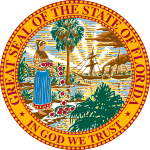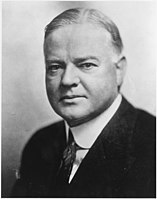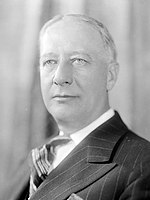| ||||||||||||||||||||||||||
| ||||||||||||||||||||||||||
 County Results
| ||||||||||||||||||||||||||
| ||||||||||||||||||||||||||
| Elections in Florida |
|---|
 |
|
|
The 1928 United States presidential election in Florida was held on November 6, 1928, as part of the 1928 United States presidential election held throughout all contemporary forty-eight states. Florida voters chose six electors, or representatives to the Electoral College, who voted for president and vice president.
Ever since the disfranchisement of blacks at the beginning of the 1890s, Florida had been a one-party state ruled by the Democratic Party. The disfranchisement of blacks and poor whites by poll taxes in 1889[1] had left the Republican Party – between 1872 and 1888 dependent upon black votes – virtually extinct. With the single exception of William Howard Taft's win in Calhoun County in 1908[2] the Democratic Party won every county in Florida in every presidential election from 1892[a] until 1916. Only twice – and never for more than one term – did any Republican serve in either house of the state legislature between 1896 and 1928. Despite this Democratic dominance and the restrictions on the franchise of the poorer classes due to the poll tax, significant socialist movements were to develop and persist in Tampa[3] and to a lesser extent over other parts of the state, especially against the powerful Ku Klux Klan.[4] There was also a powerful Prohibitionist movement in older North Florida, which saw the Prohibition Party even win the governorship for one term under the notorious anti-Catholic minister Sidney J. Catts, who was later to be a major foe of Alfred Emmanuel Smith.[5]
The 1920 presidential election saw Warren Harding, aided substantially by isolationist sentiment in the region,[6] gain more support in the former Confederacy than any Republican since black disfranchisement, in the process winning three Florida counties.[2] Calvin Coolidge in 1924 was to do no more than maintain these gains, but did show that the presidential GOP vote from transplanted Northerners was equal to or greater than the traditional Unionist GOP vote (which Florida entirely lacked) of Texas, Arkansas, Alabama or Georgia.[6]
During the months between the beginning of the campaign and the actual vote, a number of newspapers – including the Orlando Sentinel and the St. Petersburg Times – utilized voting machines to take a sample ballot.[7] All these polls, in spite of the fact that the newspapers in question favored Smith, gave large majorities to Hoover, in the case of the Times by over two-to-one. Despite these polls, Smith campaigners took a long time to realize the danger that he would not carry the traditional "Solid South".[8]
After a heated campaign in which he had played little part, Herbert Hoover won Florida against Al Smith by 42,404 votes or by a margin of 16.71 percentage points.[9] Vis-à-vis the 1924 election, swings of up to 100 percentage points occurred in the western Panhandle pineywoods, where opposition to Smith's Catholic religion reached the fanatical,[10] and Hoover also gained from increased Republican voting by northern migrants in Miami, Tampa, Fort Lauderdale, Sarasota and Jacksonville, along with the growth of an urban middle class in those cities.[10] This was the first time since 1876 that the state voted Republican. The 1928 US presidential election would be the first time that Florida would become a crucial bellwether state in presidential elections: from 1928 and on, the winner of the presidential election has carried the state in every election except in 1960, in 1992, and in 2020.[11]
In contrast, the counties of the central and eastern Panhandle remained loyal to Smith, who still carried ten counties in this region, all over thirty-five percent nonvoting African-American, by three-to-one or larger majorities, because they saw party regularity as essential to preserving white supremacy against African Americans.[12] However, unlike Alabama and Georgia, Florida lacked the strength to counter anti-Catholic voting – which was indeed stronger than in most other parts of the white South – with the result that Hoover gained his largest margin among the five Confederate states he carried.
- ^ Silbey, Joel H. and Bogue, Allan G.; The History of American Electoral Behavior, p. 210 ISBN 140087114X
- ^ a b Robinson, Edgar Eugene; The Presidential Vote; 1896-1932 (second edition); pp. 156-157 Published 1947 by Stanford University Press
- ^ Ford, Edward J.; 'Life on the Campaign Trail: a Political Anthropology of Local Politics' (thesis), published 2008 by University of South Florida, pp. 114-118
- ^ Gregory, Raymond F.; Norman Thomas: The Great Dissenter, pp. 150-151 ISBN 0875866239
- ^ Okaloosa News-Journal, July 6, 1928
- ^ a b Phillips, Kevin; The Emerging Republican Majority, pp. 210-211, 261 ISBN 9780691163246
- ^ Hughes; 'The 1928 Presidential Election in Florida', pp. 150, 152
- ^ Hughes; 'The 1928 Presidential Election in Florida', p. 153
- ^ Leip, David. "1928 Presidential General Election Results – Florida". Dave Leip's Atlas of U.S. Presidential Elections. Retrieved June 2, 2017.
- ^ a b Phillips; The Emerging Republican Majority, pp. 212, 214
- ^ Paulson, Darryl (November 4, 2016). "A quick history of Florida's presidential politics, from Whigs to wigged out". Tampa Bay Times. Retrieved July 7, 2019.[dead link]
- ^ Key, V.O. junior; Southern Politics in State and Nation; p. 328 ISBN 087049435X
Cite error: There are <ref group=lower-alpha> tags or {{efn}} templates on this page, but the references will not show without a {{reflist|group=lower-alpha}} template or {{notelist}} template (see the help page).


